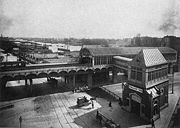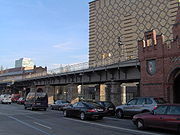
Stralauer Tor (Berlin U-Bahn)
Encyclopedia


Berlin U-Bahn
The Berlin is a rapid transit railway in Berlin, the capital city of Germany, and is a major part of the public transport system of that city. Opened in 1902, the serves 173 stations spread across ten lines, with a total track length of , about 80% of which is underground...
station in Berlin-Friedrichshain. As an elevated station built into the north-eastern part of the Oberbaumbrücke
Oberbaumbrücke
The Oberbaum Bridge is a double-deck bridge crossing Berlin's River Spree, considered one of the city landmarks. It links Friedrichshain and Kreuzberg, former boroughs that were divided by the Berlin Wall, and has become an important symbol of Berlin’s unity....
viaduct, it operated between Warschauer Straße and Schlesisches Tor
Schlesisches Tor (Berlin U-Bahn)
Schlesisches Tor is a Berlin U-Bahn station on the line.-Overview:It is located in eastern Kreuzberg, near Oberbaumbrücke, in the Bohemian quarter commonly known as SO36...
stations on today's U1
U1 (Berlin U-Bahn)
U1 is a line on the Berlin U-Bahn, which is 8.8 km long and has 13 stations. Its traditional line designation was BII. It runs east-west and its eastern end is immediately south of the route of the historical Schlesischen Bahn at the Warschauer Straße S-Bahn station and runs through...
. Having been completely destroyed in World War II
World War II
World War II, or the Second World War , was a global conflict lasting from 1939 to 1945, involving most of the world's nations—including all of the great powers—eventually forming two opposing military alliances: the Allies and the Axis...
it was never rebuilt and remains to this day one of Berlin's two U-Bahn stations (the other was Nürnberger Platz
Nürnberger Platz (Berlin U-Bahn)
Nürnberger Platz was a Berlin U-Bahn station on what is now the , located under the square of the same name in Wilmersdorf on the border with Charlottenburg...
, which was closed and demolished in 1961) to have been abandoned after having previously been in service.
History
When the ground-breaking ceremony for the construction work Straulauer Thor was held on 10 September 1896 it effectively laid one of the foundation stones of today's U-Bahn network, as the new elevated station would mark the eastern end of the city's very first elevated and subterranean electric train line - with the western end terminating at Potsdamer Platz. However, although its historic status remains intact, it role as line terminus would be short-lived, as six months after the station opened to the public on 15 February 1902, the present terminus Warschauer Straße (then named Warschauer Brücke) assumed the role, opening for service on 17 August 1902.The design of Stralauer Tor astride the north-eastern end of the Oberbaumbrücke was conceived before the bridge was built. The construction of both edifices took place consecutively; for once Otto Stahn had directed the erection of the bridge between 1894 and 1896, the architect firm Siemens & Halske
Siemens & Halske
Siemens & Halske AG was a German electrical engineering company that later became part of Siemens AG.It was founded on 12 October 1847 as Telegraphen-Bauanstalt von Siemens & Halske by Ernst Werner von Siemens and Johann Georg Halske...
set about integrating their new station into the viaduct design.
Stralauer Tor was renamed Osthafen in 1924.
The station closed permanently on 10 March 1945 owing to severe bombing damage. Some thought was given to rebuilding the station after the war, and it appears on a 1946 Berlin map, renamed as Besarinstraße, but no work was undertaken.
The reason for this was in part due to the short distance to Warschauer Straße station - only 320 metres away - and the destruction of many buildings around Stralauer Tor, but more importantly this was because its the border between Friedrichshain and Kreuzberg
Kreuzberg
Kreuzberg, a part of the combined Friedrichshain-Kreuzberg borough located south of Mitte since 2001, is one of the best-known areas of Berlin...
across the river that it stood astride became the border between the Soviet and American sectors of occupation, and thus East
East Berlin
East Berlin was the name given to the eastern part of Berlin between 1949 and 1990. It consisted of the Soviet sector of Berlin that was established in 1945. The American, British and French sectors became West Berlin, a part strongly associated with West Germany but a free city...
and West Berlin
West Berlin
West Berlin was a political exclave that existed between 1949 and 1990. It comprised the western regions of Berlin, which were bordered by East Berlin and parts of East Germany. West Berlin consisted of the American, British, and French occupation sectors, which had been established in 1945...
.
With the construction of the Berlin Wall
Berlin Wall
The Berlin Wall was a barrier constructed by the German Democratic Republic starting on 13 August 1961, that completely cut off West Berlin from surrounding East Germany and from East Berlin...
along this frontier in 1961, the section across the bridge into East Berlin was abandoned, and only the part of the line in West Berlin
West Berlin
West Berlin was a political exclave that existed between 1949 and 1990. It comprised the western regions of Berlin, which were bordered by East Berlin and parts of East Germany. West Berlin consisted of the American, British, and French occupation sectors, which had been established in 1945...
stayed open, terminating at Schlesisches Tor. Following German reunification
German reunification
German reunification was the process in 1990 in which the German Democratic Republic joined the Federal Republic of Germany , and when Berlin reunited into a single city, as provided by its then Grundgesetz constitution Article 23. The start of this process is commonly referred by Germans as die...
, the remainder of the line reopened in 1995, but Stralauer Tor was not reconstructed. Today, only struts on the viaduct remain to indicate its location.

